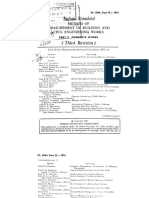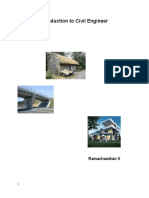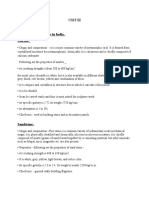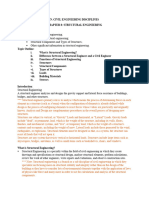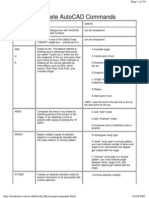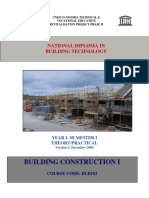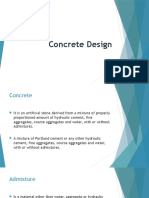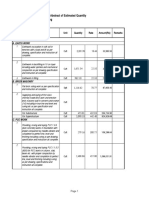Professional Documents
Culture Documents
Lec 14 Masonry
Lec 14 Masonry
Uploaded by
amjad aliOriginal Description:
Original Title
Copyright
Available Formats
Share this document
Did you find this document useful?
Is this content inappropriate?
Report this DocumentCopyright:
Available Formats
Lec 14 Masonry
Lec 14 Masonry
Uploaded by
amjad aliCopyright:
Available Formats
LECTURE #14
Brick masonry
Brick masonry is built with bricks bonded together with mortar. For temporary sheds mud mortar
may be used but for all permanent buildings lime or cement mortars are used.
Terms Used In Brick Masonry
Frog: the depression provided at the face of the brick during its manufacturing is called the frog.
Course: A course is a horizontal layer of bricks or stones
Face: The exterior of the wall exposed to weather is known
as face. The material used in the facing of wall is known as
Facing’
Hearting: It is the interior portion of a wall between facing
And backing
Header and heading course
A brick layed in brickwork with its width in elevation is called a header and the course in which
all the bricks are laid as headers is called heading course.
Stretcher and stretching course
A brick laid in brick work with its length in elevation is called stretcher and the course in which
the stretcher is laid is called stretching course.
Quoins: the external corners of walls of structure are called quoins.
Quoin brick: the brick forming the external corner of wall is called quoin brick.
Bat: It is a portion of a brick cut across the width.
Closer: It is the portion of a brick cut in such a manner that its one long face remains uncut
Queen closer: it is the portion of a brick obtained by cutting a brick length-wise into two
portions
King closer: It is the portion of brick obtained by cutting off the triangular piece between the
centre of one end and the centre of one side.
Types of bonds in brickwork and their suitability
The various types of bonds generally used in brick masonry are
English bond
Flemish bond
Header bond
Stretcher bond
Garden wall bond
Raking bond
Facing bond
English Bond
In this alternate courses consist of headers and stretchers.
This is considered to be the strongest bond. Hence it is commonly used bond for the walls of all
thicknesses. To break continuity of vertical joints a brick is cut lengthwise into two halves and
used in the beginning and end of a wall after first header. This is called queen closer
By Engr. Asghar Hussain Shah Page 1
LECTURE #14
Flemish Bond
In this type of bond each course comprises of alternate header and stretcher.. To break the
continuity of vertical joints queen closers are required, if a course starts with header. Every
header is centrally supported on the stretcher below it.
Flemish bonds may be further classified as
(a) Double Flemish Bond
(b) Single Flemish Bond.
In case of double Flemish bond, both faces of the wall have Flemish look, i.e. each course
consist of alternate header and stretcher
whereas in single Flemish bond outer faces of walls have Flemish look whereas inner faces have
look of English bond.
By Engr. Asghar Hussain Shah Page 2
LECTURE #14
1. Stretcher bond
In stretcher bond masonry all the bricks are arranged in stretcher courses as shown in Fig. every
alternate course is to be started with ½ brick bats for breaking the continuity of vertical joints.
This type of construction is useful for the construction half brick thick partition wall.
. 2. Header bond
By Engr. Asghar Hussain Shah Page 3
LECTURE #14
In header bond brick masonry all the bricks are arranged in the header courses as shown in Fig.
every alternate course is to be started with ¾ brick bats for breaking the continuity of vertical
joints .This type of bond is useful for the construction of one brick thick walls.
Garden
wall
bond:
This type
of bond is
employed
for the
construction of garden walls, compound walls, boundary walls etc.
This wall bond can be both English as well as Flemish
The garden wall bond heading course is provided after 3 to 5 stretching courses is called English
garden wall bond.
The garden wall bond having header provided after 3 to 5 stretchers in each course is called
Flemish garden wall bond.
Facing bond: In this type of bond bricks of different thickness are used in the facing and
backing of the wall. In this case, a header course is placed after several stretcher courses. In this
type of bond, the distance between the successive heading courses is equal to common multiple
of thickness of backing and facing bricks.
Dutch bond:
This is the modified form of English bond. The corners of the wall provided with dutch bond are
quite strong. The alternate courses in this type of bond are headers and stretchers. In stretcher
By Engr. Asghar Hussain Shah Page 4
LECTURE #14
course ¾ bat is used as quoin. A header is placed next to the ¾ bat in every alternate stretcher
course as
shown in
the fig
It is used
only for
brick
work
where
strength
is of
prime
importance.
Monk bond
The bond having two stretchers and one header laid alternately in each course is called monk
bond.
Suitability
This type of bond is used for the construction of boundary walls where bricks of inferior quality
are to be used for backing.
Brick nomenclature
I. Nomenclature based on brick size
Frequently, the Builder must cut the brick into various shapes. The most common shapes are
shown in figure .They are called half or bat, three-quarter closure, quarter closure, king
closure, queen closure, and split. They are used to fill in the spaces at corners and such
other places where a full brick will not fit. The six surfaces of a brick are called the cull, the
beds, the side, the end, and the face, as shown
By Engr. Asghar Hussain Shah Page 5
LECTURE #14
ii. Nomenclature based on climatic conditions
This type of classification divides brickinto grades according to the probable climatic
conditions to which it is to be exposed.
GRADE SW is brick designed to withstand exposure to below-freezing temperatures in a
moist climate like that of the northern regions of the United States.
GRADE MW is brick designed to withstand exposure to below-freezing temperatures in a drier
climate than that mentioned in the previous paragraph.
GRADE NW is brick primarily intended for interior or backup brick. It may be used exposed,
however, in a region where no frost action occurs, or in a region where frost action occurs, but
the annual rainfall is less than 15 in.
Tools used in brick masonry
Trowel
This is the most important tool used in brick masonary.
It is available in various sizes ranging from 50mm to 300mm in length.
Used for lifting and spreading mortar.
Brick hammer
One end of this hammer is square and the other is sharp edged.
Line and pins
Used for maintaining the correct alignment of the courses.
Spirit level or bubble tube
This is used for checking the level of floors and roofs.
Plumb rule and bob
This tool is used for checking the verticality of the faces of brickwork.
Mason’s square
This is right angle piece made of steel or wooden section.
It is used for checking perpendicularity during the construction of square quoins in brick
masonry.
By Engr. Asghar Hussain Shah Page 6
LECTURE #14
A small steel tape
This is usually a steel tape having a 2 m length, marked upto one tenth of centimeter.
It is used for taking and checking small measurements.
Stone Masonry
Stone masonry: The construction of stones bonded together with Mortar is termed as stone
masonry.
Tools required for stone masonry construction:
a) Trowel : This is used to lift and spread mortar
b) Square: This is made of flat steel having each arm about
0.5m long
c) Plumb rule and bob: This is used to check the vertically of
walls
d) Spirit level: this is used to check the horizontality of walls
e) Line and pin: This is used to maintain the alignment of the
work in progress
f) Bevel: The instrument used to set right angles
g) Pick axe: This is employed for dressing of rough stone and
split the stones in the quarry
h) Crowbar: This is used to make stones in query
i) Chisels: They are used to dress stones
j) Spall hammer: This is heavy hammer used for rough dressing of stones
k) Mallet: The wooden hammer used for driving of wooded headed chisels
l) Iron hammer: This is used for carving of stones
m) Scabbling hammer: This is used to break small projections
of stones
n) Pitching tool: This is used to make the stones of required size
o) Gauge: this is employed to dress stones for spring course,
comice, coping etc
p) Claw tool: This is employed for dressing the surface of
stones
q) Nicker: This is employed to draw fine chisel lines on the
stone surface
r) Jumper: They are used for boring holes
s) Wedge and feathers: They are employed for cutting the
stones after they have been bored with jumper.
t) Gad: A small steel wedge used for splitting of stones
u) Drag: This is employed to level a stone surface
v) Punch: This is employed to dress roughly the stones
w) Handsaw: This is used to cut soft stones
x) Cross-cut saw: This is used to cut hard stones
By Engr. Asghar Hussain Shah Page 7
LECTURE #14
y) Frame saw: This is used to cut large blocks of stones.
Terms used in stone masonry
Corbel: A corbel is a projecting stone which is usually provided to serve as support for roof
truss, beam, weather shed, etc. The corbels are generally moulded and given ornamental
treatment. The corbels should extend at least two-third of their length into the wall.
Cornice: A cornice is a course of stone provided at the top of wall. It is generally moulded and
given ornamental treatment. It is weathered and throated to dispose off rain water. In order to
prevent the overturning of the cornice, sufficient bearing and extra weight at the top in the form
of a parapet wall should be provided.
The exterior trim where the roof meets the wall
Parapet: it is the portion of low height wall constructed along the edge of the roof to protect the
users from falling.
Column: it is a vertical load bearing member of masonry which is constructed in an isolation
from the wall and whose width does not exceed four times its thickness.
Lintel: it is a horizontal member of stone, brick, wood, steel or reinforced concrete used to
support the masonry and the super imposed load above an opening.
Sill: the bottom surface of door or window opening is known as sill. It gives support for the
vertical member of the opening and also to shed off rain water from the face of the wall
immediately below the opening.
Joint: the junction of adjacent units of stones or bricks is known as joint.
Gable: it is triangular shaped masonry work, provided at the ends of a sloped roof.
Spalls: spalls are smaller pieces of stones obtained as a result of reducing big blocks of stones
into regular stone blocks.
String course: a continuous horizontal course of masonry projecting from the face of wall for
shedding rain water off the face is termed as a string course.
It is generally provided at every floor and sill level. It breaks the monotony of a plane surface
and hence imparts aesthetic appearance to the structure. The string course is suitably weathered
and throated so as to throw off the rain water clear of the wall surface.
Types of stone masonry:
1. Rubble Masonry:
The stone masonry in which either undressed or roughly dressed stone are laid in a suitable
mortar is called rubble masonry. In this masonry the joints are not of uniform thickness.
Rubble masonry is further sub-divided into the following three types:
1. Random rubble masonry
2. Squared rubble masonry
3. Dry rubble masonry
The random rubble masonry in which stones are laid without forming courses is known as un
coursed random rubble masonry. This is the roughest and cheapest type of masonry and is of
varying appearance
Suitability: Used for construction of walls of low height in case of ordinary
By Engr. Asghar Hussain Shah Page 8
LECTURE #14
Buildings
b. Coursed random rubble masonry: The random rubble masonry in which stones are laid in
layers of equal height is called random rubble masonry. In this
masonry, the stones are laid in somewhat level courses.
Suitability:
Used for construction of residential buildings, go downs, boundary
walls etc.
2. Squared rubble masonry: The rubble masonry in which the face stones are squared on all
joints and beds by hammer dressing or chisel dressing before their actual laying, is called
squared rubble masonry.
There are two types of squared rubble masonry.
a. Coursed Square rubble masonry: The square rubble masonry in which chisel
dressed stones laid in courses is called coarse square rubble masonry. This is a superior variety
of rubble masonry. It consists of stones, which are squared on all
joints and laid in courses. The stones are to be laid in courses of equal layers. and the joints
should also be uniform.
Suitability: Used for construction of public buildings, hospitals, schools, markets,
modern residential buildings etc and in hilly areas where good quality of stone is
easily available.
b. Un coursed square rubble masonry: The squared rubble in masonry which hammer dressed
stones are laid without making courses is called un coursed square rubble masonry. It consists of
stones which are squared on all joints and beds by hammer dressing. All the stones to be laid are
of different sizes.
Suitability: Used for construction of ordinary buildings in hilly areas where a good variety of
stones are cheaply available.
3. Dry rubble masonry: The rubble masonry in which stones are laid without using any mortar
is called dry rubble masonry or sometimes shortly as "dry stones". It is an ordinary masonry and
is recommended for constructing walls of height not more than 6m. In case the height is more,
three adjacent courses are laid in squared rubble masonry mortar at 3m intervals
Ashlar masonry
The stone masonry in which finely dressed stones are laid in cement or lime mortar is known as
ashlars masonry. In this masonry all the courses are of uniform height, all the joints are regular,
thin and have uniform thickness. This type of masonry is much costly as it requires dressing of
stones.
Suitability: This masonry is used for heavy structures, architectural buildings, high piers and
abutments of bridges.
Ashlars masonry is further sub divided into the following types:
1. Ashlars fine or coarse ashlar masonry
2. Random coarse ashlars masonry
3. Rough tooled ashlar masonry
By Engr. Asghar Hussain Shah Page 9
LECTURE #14
4. Rock or quarry faced ashlars masonry
5. Chamfered ashlars masonry
6. Block in coarse masonry
7. Ashlar facing
1. Ashlars fine or coarse ashlar masonryIn this type of stone masonry stone blocks of same
height in each course are used. Every stone is fine tooled on all sides. Thickness of mortar is
uniform throughout. It is an expensive type of stone masonry as it requires heavy labor and
wastage of material while dressing. Satisfactory bond can be obtained in this type of stone
masonry
Random coursed ashlar masonry: This type of ashlar masonry consists of fine or coursed
ashlar but the courses are of varying thick nesses, depending upon the character of the building.
Rough tooled ashlar masonry: This type of ashlar masonry the sides of the stones are rough
tooled and dressed with chisels. Thickness of joints is uniform, which does not exceed 6mm.
Rock or quarry faced ashlar masonry: This type of ashlar masonry is similar to rough tooled
type except that there is chisel-drafted margin left rough on the face which is known as quarry
faced.
Chamfered ashlar masonry: It is similar to quarry faced except that the edges are beveled or
chamfered to 450 for depth of 2.5 cm or more.
Block-in course masonry: It is the name given to a class of ashlar masonry which occupies an
intermediate place between rubble and ashlars. The stones are all squared and properly dressed.
It resembles to coursed rubble masonry or rough tooled ashlar masonry.
Ashlar facing: Ashlar facing is the best type of ashlars masonry. Since this is type of masonry is
very expensive, it is not commonly used throughout the whole thickness of the wall, except in
works of great importance and strength. For economy the facing are built in ashlars and the rest
in rubble.
By Engr. Asghar Hussain Shah Page 10
You might also like
- Mezzanine Floor DetailsDocument1 pageMezzanine Floor DetailsSuman Kumari100% (1)
- House Construction - Structural Building - Wikibooks, Open Books For An Open WorldDocument8 pagesHouse Construction - Structural Building - Wikibooks, Open Books For An Open WorldJojo JojoNoch keine Bewertungen
- Project: NIEC Building Location: Lalitpur: Detailed Quantity EstimateDocument4 pagesProject: NIEC Building Location: Lalitpur: Detailed Quantity EstimateSANDESH50% (2)
- Types of FlooringDocument12 pagesTypes of FlooringVarun100% (1)
- Preperation FileDocument17 pagesPreperation FileM Srinu RaoNoch keine Bewertungen
- Walls and PartitionsDocument13 pagesWalls and PartitionsSandip BudhathokiNoch keine Bewertungen
- Lecture AllDocument58 pagesLecture Alldwk100% (2)
- Changes and Impact - Chapter 3,4,5,6Document69 pagesChanges and Impact - Chapter 3,4,5,6crvillateNoch keine Bewertungen
- Is1200 (Part2) 1974Document14 pagesIs1200 (Part2) 1974Gururaj P KundapurNoch keine Bewertungen
- Introduction To Civil Engineer: Ramachandran VDocument153 pagesIntroduction To Civil Engineer: Ramachandran VAnonymous aa3oXQowXNoch keine Bewertungen
- Paya-ZafortezaGarlock - Structural Engineering Heroes and Their Inspirational JourneyDocument15 pagesPaya-ZafortezaGarlock - Structural Engineering Heroes and Their Inspirational JourneyMilchoNoch keine Bewertungen
- Old Cornish Crosses 00 LangDocument540 pagesOld Cornish Crosses 00 LangyahyaNoch keine Bewertungen
- RwallDocument51 pagesRwallandualemNoch keine Bewertungen
- Masonry Building Tech NotesDocument13 pagesMasonry Building Tech Notescorazon phil100% (1)
- Stone As A Building MaterialDocument6 pagesStone As A Building Materialsanchit2203Noch keine Bewertungen
- Teaching Manuscript 3 BUILDINGDocument107 pagesTeaching Manuscript 3 BUILDINGyabetymarthaNoch keine Bewertungen
- BCM Notes Unit IIIDocument10 pagesBCM Notes Unit IIIMahesh RamtekeNoch keine Bewertungen
- Introduction To Civil Engineering by Ramachandran VDocument157 pagesIntroduction To Civil Engineering by Ramachandran VXaviorOuseph100% (4)
- State-of-the-Art Report On High-Strength Concrete: ACI 363R-92Document55 pagesState-of-the-Art Report On High-Strength Concrete: ACI 363R-92Sahil GandhiNoch keine Bewertungen
- Building Technology and Materials I PDFDocument4 pagesBuilding Technology and Materials I PDFShubhankar JainNoch keine Bewertungen
- Civil Module 1 NotesDocument36 pagesCivil Module 1 NotesPrateek MalagundNoch keine Bewertungen
- Stone Veneer-Faced Precast Concrete PanelsDocument28 pagesStone Veneer-Faced Precast Concrete PanelsdantranzNoch keine Bewertungen
- 3tq3f Basic Knowledge in Civil Engineering Book of 59 Topics Including History of Civil Engineering NR 1Document148 pages3tq3f Basic Knowledge in Civil Engineering Book of 59 Topics Including History of Civil Engineering NR 1La0% (1)
- Building TechDocument16 pagesBuilding TechKen AndreiNoch keine Bewertungen
- Basics of Building ConstructionDocument5 pagesBasics of Building ConstructionSirimilla Mehar100% (1)
- CONCRETE Book SubmissionDocument41 pagesCONCRETE Book SubmissionAminah KamranNoch keine Bewertungen
- Doors and WindowsDocument45 pagesDoors and WindowsShreyas AlagundiNoch keine Bewertungen
- BLD 112 Lecture NoteDocument42 pagesBLD 112 Lecture NoteUmar Bello NuhuNoch keine Bewertungen
- Dampness in Buildings: (Causes & Remedial Measures)Document24 pagesDampness in Buildings: (Causes & Remedial Measures)Abuzar AliNoch keine Bewertungen
- Structural Engineering AdditionalDocument8 pagesStructural Engineering AdditionalAlenna CataloniaNoch keine Bewertungen
- Complete AutoCAD CommandsDocument39 pagesComplete AutoCAD Commandskxalxo7637Noch keine Bewertungen
- Keyboard Function KeysDocument9 pagesKeyboard Function KeysAlif Irfan100% (1)
- English Index To The Dictionaries of ManDocument132 pagesEnglish Index To The Dictionaries of ManMilad AbediNoch keine Bewertungen
- Basic Civil NotesDocument43 pagesBasic Civil Notessyedaleem1167100% (2)
- Brickwork: Definition and Important TermsDocument3 pagesBrickwork: Definition and Important TermsSiti Rohani Isdris100% (1)
- Brick Lab-2 English BondDocument12 pagesBrick Lab-2 English BondasdqwerNoch keine Bewertungen
- Building Technology 0Document30 pagesBuilding Technology 0Tichaona MutukumiraNoch keine Bewertungen
- MarkingDocument6 pagesMarkingMalith De SilvaNoch keine Bewertungen
- 30 Great AutoCAD Secrets You Didn't Know - ArchiStar AcademyDocument13 pages30 Great AutoCAD Secrets You Didn't Know - ArchiStar AcademyAshok MalkudNoch keine Bewertungen
- A Truss Is Essentially A Triangulated System ofDocument10 pagesA Truss Is Essentially A Triangulated System ofMohammed HazemNoch keine Bewertungen
- Cec312 Lectures Note 2022docxDocument37 pagesCec312 Lectures Note 2022docxishaq kazeemNoch keine Bewertungen
- Roof Design Principles: GenerallyDocument55 pagesRoof Design Principles: Generallyrcxy98Noch keine Bewertungen
- How To Learn To Read BlueprintsDocument5 pagesHow To Learn To Read Blueprintsimgtx100% (1)
- Quick Start Guide: For Support & Training Please ContactDocument25 pagesQuick Start Guide: For Support & Training Please ContactApolzan George DorinNoch keine Bewertungen
- Types of Houses: Vintila Luiza Ana-MariaDocument10 pagesTypes of Houses: Vintila Luiza Ana-Mariaana ghineaNoch keine Bewertungen
- Miss Design ManualDocument65 pagesMiss Design Manualengsam777Noch keine Bewertungen
- Texas RoundhouseDocument13 pagesTexas RoundhousejosemiguelreyesNoch keine Bewertungen
- All Networking MultichoiceDocument160 pagesAll Networking MultichoicesauravnarukaNoch keine Bewertungen
- Design, Loading & Structural SystemDocument75 pagesDesign, Loading & Structural SystemLuqman_Haqeem_3054100% (2)
- GBC Mod I-IIIDocument218 pagesGBC Mod I-IIIBrian KoechNoch keine Bewertungen
- Structure May 2019 MagazineDocument76 pagesStructure May 2019 MagazineMatumbi NaitoNoch keine Bewertungen
- Construction DefectsDocument41 pagesConstruction DefectsItchater Paz100% (2)
- Building Construction and Finishing PDFDocument141 pagesBuilding Construction and Finishing PDFMenteri Passola100% (3)
- Concrete and Reinforced ConcreteDocument116 pagesConcrete and Reinforced ConcreteNikki OloanNoch keine Bewertungen
- Notes On Brick MasonaryDocument11 pagesNotes On Brick MasonaryVishal SuryawanshiNoch keine Bewertungen
- Brick BondDocument9 pagesBrick Bond12chamchaNoch keine Bewertungen
- 4 Types of Bonds Commonly Used in Brick Masonry WorkDocument3 pages4 Types of Bonds Commonly Used in Brick Masonry WorkKalum ChandraNoch keine Bewertungen
- 4 Commonly Used Brick BondsDocument3 pages4 Commonly Used Brick BondssuryakantameNoch keine Bewertungen
- Types of Bonds in Brick Masonry: Stretcher BondDocument4 pagesTypes of Bonds in Brick Masonry: Stretcher Bondshahbaz anwerNoch keine Bewertungen
- Brick BondDocument37 pagesBrick BondHANoch keine Bewertungen
- Brick Bonding AssignmentDocument4 pagesBrick Bonding AssignmentNija AsifNoch keine Bewertungen
- Bricks MasonaryDocument40 pagesBricks Masonarydiponkar2003Noch keine Bewertungen
- Industrial Training Report: Sarhad University of Science and Information Technology PeshawarDocument11 pagesIndustrial Training Report: Sarhad University of Science and Information Technology Peshawaramjad aliNoch keine Bewertungen
- Industrial Training Report: Sarhad University of Science and Information Technology PeshawarDocument21 pagesIndustrial Training Report: Sarhad University of Science and Information Technology Peshawaramjad aliNoch keine Bewertungen
- Aqal Wazir (BUILDING)Document17 pagesAqal Wazir (BUILDING)amjad aliNoch keine Bewertungen
- Asad Water Supply ReportDocument15 pagesAsad Water Supply Reportamjad aliNoch keine Bewertungen
- Seeking Assignments As Lab Incharge Soil Test & Asphalt: Curriculam VitaeDocument4 pagesSeeking Assignments As Lab Incharge Soil Test & Asphalt: Curriculam Vitaeamjad aliNoch keine Bewertungen
- Abdul Qadsir KhanDocument36 pagesAbdul Qadsir Khanamjad aliNoch keine Bewertungen
- Overburnt BricksDocument1 pageOverburnt Bricksamjad aliNoch keine Bewertungen
- Ikram Ullah: Email AddressDocument4 pagesIkram Ullah: Email Addressamjad aliNoch keine Bewertungen
- Curriculum Vitae: Amin KhanDocument4 pagesCurriculum Vitae: Amin Khanamjad aliNoch keine Bewertungen
- Lec 11 Bituminous MaterialsDocument6 pagesLec 11 Bituminous Materialsamjad aliNoch keine Bewertungen
- Lecture #09: Timber Definition: Wood Suitable For Building or Other Engineering Purposes Is Called TimberDocument12 pagesLecture #09: Timber Definition: Wood Suitable For Building or Other Engineering Purposes Is Called Timberamjad aliNoch keine Bewertungen
- Hybrid Concrete Masonry Construction DetailsDocument8 pagesHybrid Concrete Masonry Construction DetailsB0B_PNoch keine Bewertungen
- W1, W2 Long Span StructureDocument81 pagesW1, W2 Long Span StructureMuhammad AizatNoch keine Bewertungen
- TecCrete Product Information SheetDocument2 pagesTecCrete Product Information SheetMikeNoch keine Bewertungen
- Appendix 1 Section 3 AS1668.2 2002Document5 pagesAppendix 1 Section 3 AS1668.2 2002bobNoch keine Bewertungen
- Offer For Ink and Chemical StorageDocument5 pagesOffer For Ink and Chemical StorageMd. Abdul HaiNoch keine Bewertungen
- 1.1 Background and Scope of StudyDocument21 pages1.1 Background and Scope of StudyAhmad Aufa AfdhaluddinNoch keine Bewertungen
- R-Values of Insulation and Other Building MaterialsDocument8 pagesR-Values of Insulation and Other Building MaterialsDhanyaUnniNoch keine Bewertungen
- Bill of Quanitties and Materials: General RequirementsDocument66 pagesBill of Quanitties and Materials: General RequirementsJoel King AzaresNoch keine Bewertungen
- Buddhism Part-1 PDFDocument111 pagesBuddhism Part-1 PDFLakshay BansalNoch keine Bewertungen
- NCC2019 Update: Welcome To The AIRAH Vic Divisional SeminarDocument25 pagesNCC2019 Update: Welcome To The AIRAH Vic Divisional SeminarFahim miriNoch keine Bewertungen
- Roman ArchitectureDocument9 pagesRoman ArchitectureXlyth RodriguezNoch keine Bewertungen
- Hill Side Resort ReportDocument51 pagesHill Side Resort ReportSHristi ShaRmaNoch keine Bewertungen
- Sample Report Wind Claim Shake RoofDocument13 pagesSample Report Wind Claim Shake RoofTroy HoveyNoch keine Bewertungen
- Shear Key or Shear Lug Design - US AISC SectionDocument3 pagesShear Key or Shear Lug Design - US AISC SectionYash PaulNoch keine Bewertungen
- Daylight Factor: Prasented byDocument8 pagesDaylight Factor: Prasented byDebayan dasNoch keine Bewertungen
- Shankar Building EstimateDocument16 pagesShankar Building EstimateSunil Boyz-uNoch keine Bewertungen
- Building Power Point PresentationDocument121 pagesBuilding Power Point PresentationAbhishek BardhanNoch keine Bewertungen
- BOM FormatDocument9 pagesBOM FormatSole Kicks PHNoch keine Bewertungen
- Byzantine Architecture REPORTDocument62 pagesByzantine Architecture REPORTSAURABH KUMAR SINGHNoch keine Bewertungen
- MS Project 2013Document42 pagesMS Project 2013jasekan.dcNoch keine Bewertungen
- Column LayoutDocument1 pageColumn Layoutlagnajit dasNoch keine Bewertungen
- Retrofit and RepairDocument6 pagesRetrofit and RepairmgrubisicNoch keine Bewertungen
- L&T MLCP East Block HVAC Heat Load SUMMARYDocument3 pagesL&T MLCP East Block HVAC Heat Load SUMMARYSatheesh Kumar NatarajanNoch keine Bewertungen
- Builder Guideline Booklet (USA) - JAN 2022 - Website EditionDocument64 pagesBuilder Guideline Booklet (USA) - JAN 2022 - Website EditionTreyNoch keine Bewertungen
- Bubble DeckDocument12 pagesBubble DeckConstantin OvidiuNoch keine Bewertungen
- BOR Facilities Condition Assessment Report Template 07.17.18Document19 pagesBOR Facilities Condition Assessment Report Template 07.17.18Christopher Blinston100% (1)
- Material Specification Slab: Second Floor Design Criteria (NSCP 2015, TABLE 204-2)Document4 pagesMaterial Specification Slab: Second Floor Design Criteria (NSCP 2015, TABLE 204-2)hhhh0% (1)
- SpecificationsDocument1 pageSpecificationssiddheartttNoch keine Bewertungen








